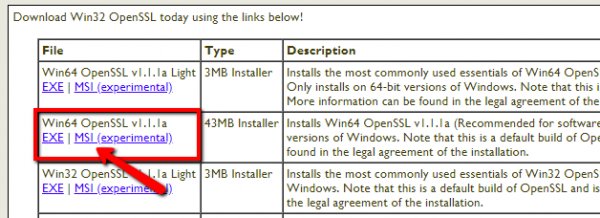

- #INSTALL OPENSSL WINDOWS 10 INSTALL#
- #INSTALL OPENSSL WINDOWS 10 FULL#
- #INSTALL OPENSSL WINDOWS 10 SOFTWARE#
- #INSTALL OPENSSL WINDOWS 10 DOWNLOAD#
It would then be compromised and the security of your site would be as well. Warning: Do not ever give us or any other third part the private key file. Keep the private key file safe (site-file.key) and copy/paste the content of the site-file.csr file in the order form. You'll get 2 files: site-file.key and site-file.csr. Let the other fields blank, they are optional. Organizational Unit Name (eg, section) : (let blank - advised - or provide a generic term such as "IT department")Ĭommon Name (eg, YOUR name) : (the name of the site to be secured) Organization Name (eg, company) : (the name of your organization) Locality Name (eg, city) : (the name of your city)
#INSTALL OPENSSL WINDOWS 10 FULL#
State or Province Name (full name) : (the name of your state in full letters) You'll be asked by the system to fill-in fileds Fill them in and respect the instructions (more information on Obtain a server certificate)Ĭountry Name (2 letter code) : (FR for example)
#INSTALL OPENSSL WINDOWS 10 DOWNLOAD#
In that case download ours and store it in C:\OpenSSL\openssl.cnf:įor Symantec or Thawte server certificates: openssl-dem-server-cert-thvs.cnfįor TBS X509 or Comodo server certificates: openssl-dem-server-cert.cnf On some platforms, the openssl.cnf file that OpenSSL reads by default to create the CSR is not the right one or does not exist. Then use this command to generate the CSR:Ĭ:\OpenSSL\bin\openssl.exe req -new -key site-file.key > site-file.csrĬ:\OpenSSL\bin\openssl.exe req -new -key site-file.key -config "C:\OpenSSL\openssl.cnf" -out site-file.csr Define a file name that suits you:Ĭ:\OpenSSL\bin\openssl.exe genrsa 2048 > site-file.key The private key is generated with the following command. To go to the repertory in which is installed OpenSSL, execute: To paste the following command lines in dos command prompt, right click and select paste. To launch the command prompt, go to the start menu and execute "cmd". Troubleshooting: execute simplified commands: OpenSSL relies here on a Linux default arborescence. Unable to load config info from /usr/local/ssl/openssl.cnf Issues encountered on Windows while generating a CSR via one commandĪccording to the version of OpenSSL you installed or to the the installation method on Windows, you may encounter error messages such as:Ĭonfig or req is not recognized as an internal or external commandĬheck the syntax and the quotes when executing your command. To do so, we advise the use of our online wizard to execute the OpenSSL command with the adequate parameters. To get (or renew or reissue) a certificate for Apache under Windows for example, you'll have to generate a CSR and its private key. Set OPENSSL_CONF=c:\OpenSSL-Win32\bin\openssl.cnfĬoncerning the version "OpenSSL v0.9.8t Light", no need for the opens.cnf file, a default configuration will be taken into account. Openssl:Error: '-config' is an invalid command. WARNING: can't open config file: /usr/local/ssl/openssl.cnf
#INSTALL OPENSSL WINDOWS 10 SOFTWARE#
>C:\OpenSSL-Win32\bin\openssl -config "C:\Program Files\Apache Software Foundation\Apache2.2\conf\openssl.cnf" We provide standard files on the bottom of this page. The repertory /usr/local/openssl not being present on Windows machines, precise with the parameter -config a path to this configuration file. The version 1.0 of OpenSSL needs a "openssl.cnf" configuration file.

To execute the programm via the Windows xommand Prompt, provide the full path: The standard installation of OpenSSL under Windows is made on "C:\OpenSSL-Win32" and the executable is stored in the sub-repertory "bin".
#INSTALL OPENSSL WINDOWS 10 INSTALL#
For certains versions of Windows (Windows 2000, windows XP.) you will have to install "Visual C++ 2008 Redistributables" as well. Then download the "binary" program for Windows: > related > Binaries :įor cryptographic standard operations linked to certificates, the "Lite" version is sufficient. You can use OpenSSL on a Windows machine to to proceed some cryptographic operations (generation of a private key, of a CSR, certificate conversion.).


 0 kommentar(er)
0 kommentar(er)
